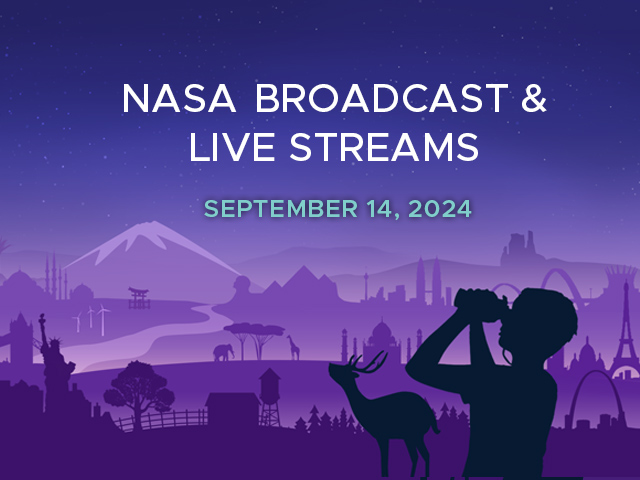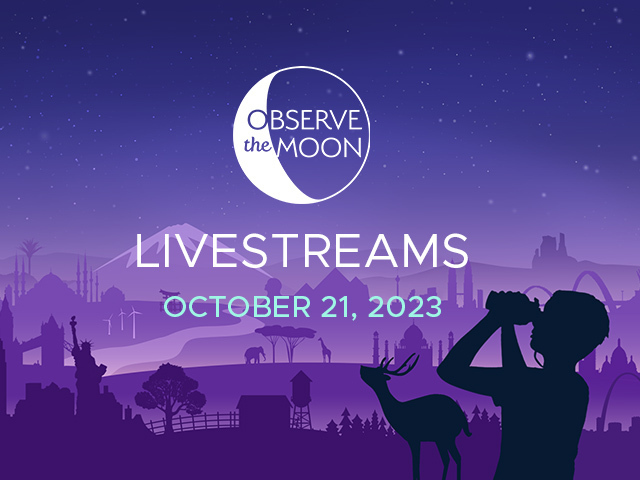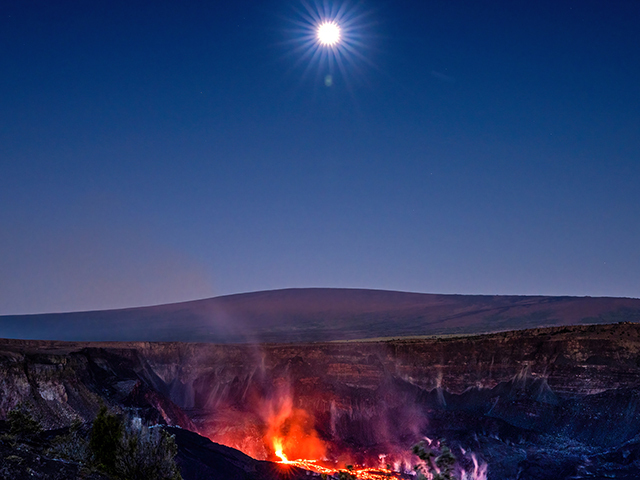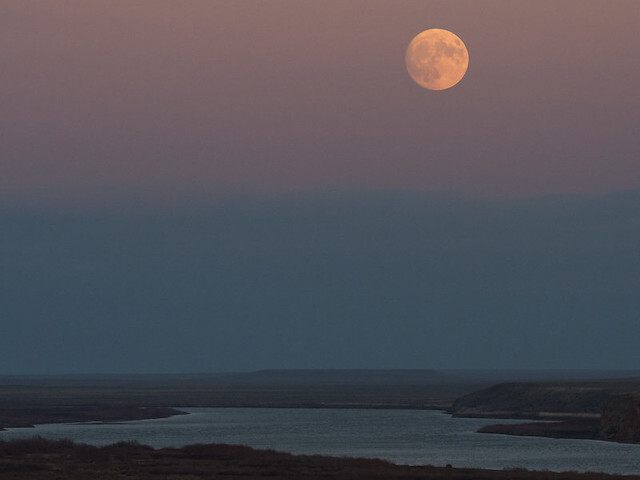News | January 29, 2018
Moon Missive: The Next Full Moon is a Super Blue Blood Moon, the Snow Moon, or the Hunger Moon
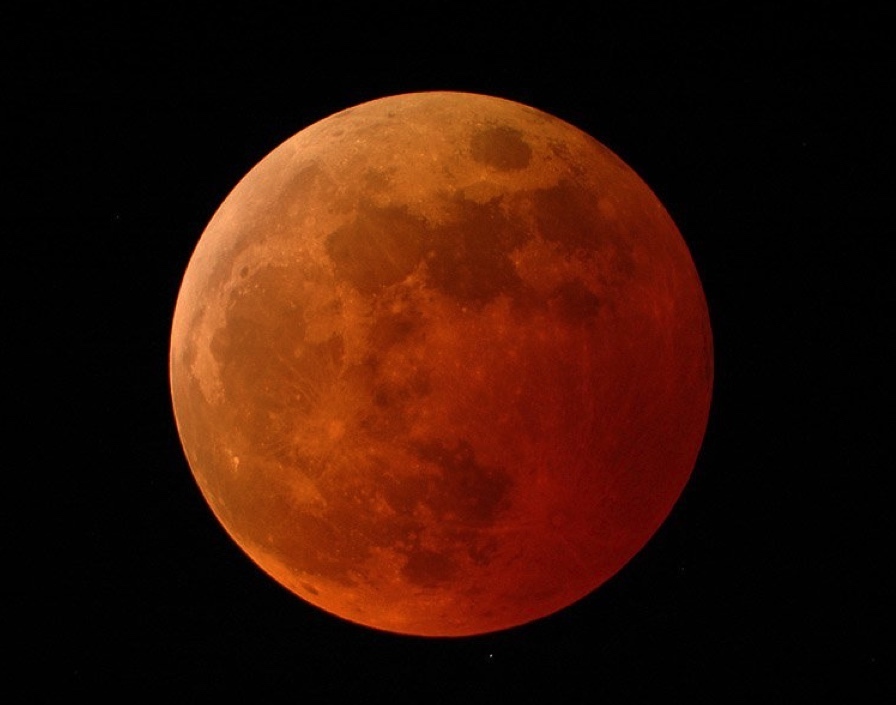
Credit: NASA
The next full Moon will be on Wednesday morning, January 31, 2018, appearing "opposite" the Sun (in Earth-based longitude) at 8:27 AM EST. The Moon will appear full for about three days around the time of the full Moon, from Monday night through Thursday morning, possibly even into the early part of Thursday evening.
In fact, the Moon will be so close to opposite that the Moon will pass through the shadow of the Earth, causing a total eclipse of the Moon. Although the Moon will begin to dim when it enters the partial shadow of the Earth, the eclipse will not become noticeable until the Moon starts entering the full shadow of the Earth at 6:48 AM EST. For the Washington, DC area, civil twilight (the time when the sky is bright enough that most days you no longer need lights) starts at 6:47 AM, just as the partial eclipse begins, when the Moon will be only about 4 degrees above the horizon in the west-northwest. With the Moon and Sun opposite each other, the Moon will set at the same time the Sun rises (at 7:15 AM EST). Before moonset, if you have a clear view of the Moon near the west-northwest horizon, you should see that the upper left quarter of the Moon will be in shadow, but the sky will probably be too bright to see the reddish glow of the shadowed part. Still, if the conditions are right and you have a clear view of the horizon, you should be able to see the shadow of the Earth stretching out through the atmosphere towards the partially shadowed Moon in the west-northwest, and opposite the Moon, see the Sun rise in the east-southeast as the Moon sets. It is rare that we get the chance to see for ourselves how we fit in the solar system.
If you live further west, your view of the eclipse will be better. From the western half of the United States, if the sky is clear, you should be able to see that the Moon in full shadow will appear reddish in color, as the light of the Sun is bent towards the Moon by the atmosphere of the Earth. This reddish glow is caused by all the sunrises and sunsets on Earth shining on the Moon at the same time. The eclipsed Moon is sometimes called the Blood Moon because of its reddish color.
Because this full Moon is the second full Moon in the month of January, this will be a Blue Moon (under one of the definitions of a Blue Moon). Originally, the term "Blue Moon" referred to the third full Moon in a season that has four full Moons. The earliest known reference to a Blue Moon in the English language is the phrase "... the mone is blewe ..." from a pamphlet published in 1528. Some writers speculate that "blue" came from "belewe," the phrase meant "Betrayer Moon," and that the name referred to how an extra Moon in a season confused or "betrayed" the dates for Lent and Easter. The newer definition of a "Blue Moon" as the second full Moon in a calendar month dates from 1946.
Because this full Moon occurs about 27 hours after perigee (the Moon's closest approach to the Earth in its orbit) this full Moon qualifies as a Supermoon. For this perigee the Moon will appear 13% wider in diameter than it will appear when at apogee later in February, making the light of the full Moon 27% brighter than it would be if the full Moon were at apogee.
As the midwinter Moon or the second full Moon of Winter, the Native American tribes of what is now the northern and eastern United States called this the Snow Moon or the Hunger Moon. It was known as the Snow Moon because of the heavy snows that fall in this season (NOAA long-term monthly averages for the Washington, DC area show January and February nearly tied as the snowiest months of the year). Bad weather and heavy snows made hunting difficult, so this Moon was also called the Hunger Moon.
In lunisolar calendars the months change with the new Moon and full Moons fall in the middle of the lunar months. This full Moon is the middle of the twelfth month of the Chinese calendar and Shevat in the Hebrew calendar. The 15th day of Shevat, corresponding with the Full Moon, is the holiday Tu BiShvat. Tu BiShvat begins at sunset on January 30 and ends at nightfall on January 31). Tu BiShvat is also called "Rosh HaShanah La'Ilanot" (literally "New Year of the Trees"). In contemporary Israel, the day is celebrated as an ecological awareness day, and trees are planted in celebration.
In the Islamic calendar the months start with the first sighting of the waxing crescent Moon a few days after the New Moon. This full Moon is near the middle of Jumada al-awwal, the fifth month of the Islamic year.
As usual, the wearing of suitably celebratory celestial attire is encouraged in honor of the full Moon.
As for other celestial events between now and the full Moon after next:
As winter continues, the daily periods of sunlight continue to lengthen. On the day of the full Moon, Wednesday, January 31, 2018, morning twilight will begin at 6:15 AM, sunrise will be at 7:15 AM, the Sun will reach a maximum altitude of 33.9 degrees at 12:22 PM, sunset will be at 5:28 PM, and evening twilight will end at 6:29 PM EST. By the day of the full Moon after next, Thursday, March 1, 2018, morning twilight will begin at 5:43 AM, sunrise will be at 6:40 AM, the Sun will reach a maximum altitude of 43.7 degrees at 12:21 PM, sunset will be at 6:01 PM, and evening twilight will end at 6:59 PM EST.
On the evening of the full Moon on January 31, 2018, as evening twilight ends, the "Summer Triangle" will be setting in the northwest, with Deneb the highest at about 23 degrees above the west-northwest horizon. The bright stars of the local arm of our home galaxy, including the constellation Orion, will appear spread across the sky from southeast to northwest. By the evening of the third full Moon of Winter at the beginning of March, as evening twilight ends, the bright stars of the local arm of our home galaxy will still appear spread across the sky. The planets Venus and Mercury will have emerged from the glow of the Sun to appear low in the west just after sunset.
On the morning of of January 31, 2018, as morning twilight begins, the planets Jupiter, Mars, and Saturn appear in the south to southeast. Jupiter will appear in the south at about 34 degrees above the horizon, Mars will appear in the south-southeast at about 29 degrees above the horizon, and Saturn will appear in the southeast at about 11 degrees above the horizon. As the month progresses, Jupiter and Saturn will appear to shift towards the west, while Mars will appear to hover in place.
On Tuesday morning, January 30, 2018, at 4:03 AM EST (2018-Jan-30 09:03 UTC), Near Earth Object (2018 BE6), between 35 and 78 meters (115 to 257 feet) in diameter, will pass the Earth at 3.4 lunar distances, traveling at 17.03 kilometers per second (38,102 miles per hour).
On Tuesday morning, January 30, 2018, at 4:58 AM EST, the Moon will be at perigee, its closest to the Earth for this orbit. At 358,994 km (223,069 miles), the Moon will appear 13.2% wider in diameter and 28.2% larger in area than it will have appeared when it was at apogee earlier in January.
As mentioned above, the next full Moon will be on Wednesday morning, January 31, 2018, at 8:27 AM EST. This full Moon will be close enough to perigee to be considered a Supermoon. As the second full Moon in January, this full Moon is also considered a Blue Moon (by a more modern definition of Blue Moon). In addition, there will be a lunar eclipse for this full Moon, which can make the Moon appear reddish in color. These make this full Moon a super blue blood Moon. For the Washington, DC area, the full shadow of the Earth will begin to fall on the Moon at 6:48 AM EST, when the sky already will be brightening with dawn and the Moon will be only 4 degrees above the horizon in the west-northwest. The part of the Moon in full shadow will increase as the Moon sets and the sky brightens towards sunrise.
Friday, February 2, 2018, is Candlemas. The tradition in some European countries was to leave Christmas decorations up until the eve of Candlemas (but it was considered bad luck to leave decorations up past Candlemas). February 2nd is also Groundhog Day, and in the U.S. we have a tradition concerning whether winter will end on Groundhog Day or six weeks later (i.e., around the time of the spring equinox), depending upon whether or not the groundhog sees its shadow. These traditions appear to tie back to European lore about whether or not a badger, wolves, or a bear (instead of a groundhog) sees its shadow. We currently divide the year into four seasons based upon the solstices and equinoxes, with winter ending on the spring equinox. Much of pre-Christian northern Europe celebrated "cross-quarter days" halfway between the solstices and equinoxes, and divided the seasons on these days, so that spring started on Imbolc in early February (the middle of our winter). Many believe that our Groundhog Day and Candlemas traditions tie back to these earlier celebrations of the start of spring (and the confusion caused by having two definitions for the end of winter). Perhaps it was best to let a groundhog’s shadow decide which definition to use for the end of winter, rather than arguing with your neighbors for the next six weeks...
Thursday evening, February 1, into Friday morning, February 2, 2018, the bright star Regulus will appear to the upper right of the full Moon. Regulus will appear at its closest to the Moon as they rise, and will appear to separate and move clockwise around the Moon as the night progresses. For the Washington, DC area, Regulus will rise a little north of east at 6:47 PM, the Moon will rise at 7:03 PM, the Moon will reach its highest in the sky for the night Friday morning at 1:55 AM, and morning twilight will begin at 6:13 AM EST. Earlier on Friday the Moon will have passed in front of Regulus, but this will only be visible from the northern parts of Europe and Asia.
On Sunday morning, February 4, 2018, at 8:46 AM EST (2018-Feb-04 13:46 UTC), Near Earth Object (2018 AH12), between 11 and 25 meters (36 to 81 feet) in diameter, will pass the Earth at 5.3 lunar distances, traveling at 5.03 kilometers per second (11,247 miles per hour).
On Sunday afternoon, February 4, 2018, at 4:31 PM EST (2018-Feb-04 21:31 UTC), Near Earth Object 276033 (2002 AJ129), between 484 and 1,082 meters (1,587 to 3,548 feet or 1/3 to 2/3 of a mile) in diameter, will pass the Earth at 10.9 lunar distances, traveling at 34.04 kilometers per second (76,143 miles per hour).
Wednesday morning, February 7, 2018, the bright planet Jupiter will appear near the waning half Moon. For the Washington, DC area, the Moon will rise in the east-southeast just after midnight at 12:25 AM, with Jupiter rising 1:12 AM EST. The Moon will appear to shift closer to Jupiter as the morning progresses. The Moon will reach its highest in the sky at 6 AM, with Jupiter to the lower left. Morning twilight will begin 9 minutes later.
Wednesday morning, February 7, 2018, the waning Moon will appear half-full. The Moon will reach its last quarter at 10:54 AM EST.
On Thursday morning, February 8, 2018, the bright planet Jupiter will appear to the upper right of the waning crescent Moon, with the planet Mars below and to the left of the Moon. For the Washington, DC area, Jupiter will rise in the east-southeast at 1:09 AM and the Moon will rise at 1:23 AM EST. The Moon will appear to move away from Jupiter and closer to Mars until these planets are lost in the glow of dawn, with morning twilight beginning at 6:08 AM.
On Friday morning, February 9, 2018, the planet Mars will appear to the lower right of the waning crescent Moon. For the Washington, DC area, the Moon will rise in the east-southeast at 2:19 AM and Mars will rise at 2:27 AM EST. They will appear to shift slightly apart until Mars is lost in the glow of dawn, with morning twilight beginning at 6:07 AM.
On Sunday morning, February 11, 2018, the bright planet Saturn will appear below the waning crescent Moon. For the Washington, DC area, the Moon will rise in the east-southeast at 4:05 AM, with Saturn rising at 4:22 AM EST. They will appear to shift closer together until Saturn is lost in the glow of dawn with morning twilight beginning at 6:05 AM. The planet Mars will appear at its closes to the bright star Antares in the southeast, with the planet Jupiter higher in the south-southeast.
Sunday morning, February 11, 2018, at 9:17 AM EST, the Moon will be at apogee, at 252,090 miles (405,700 km), its farthest from the Earth for this orbit.
Thursday, February 15, 2018, at 4:05 PM EST, will be the new Moon, when the Moon passes between the Earth and the Sun and will not be visible from most of the Earth. If you happen to be in the southernmost part of South America or parts of Antartica (and if the weather is clear), you would be able to see the silhouette of the Moon against the Sun as a partial eclipse of the Sun.
The day after the New Moon, Friday, February 16, is the Chinese New Year. The traditional celebrations start on the evening before and continue until the Lantern Festival (corresponding to the full Moon after next). See (for example) the web page at https://en.wikipedia.org/wiki/Chinese_New_Year for more information. In addition to being the start of the first month of the Chinese calendar, the day after the New Moon marks the start of the new month for most other lunisolar calendars, including the start of Adar in the Hebrew Calendar.
Saturday morning, February 17, 2018, is when the planet Mercury passes on the far side of the Sun as seen from Earth, called superior conjunction.
In the Islamic calendar the months start with the first sighting of the waxing crescent Moon a few days after the New Moon. Saturday evening, February 17, 2018, will likely mark the beginning of Jumada al-Thani, the sixth month of the calendar
On Friday morning, February 23, 2018, the Moon will appear half-full as it reaches its first quarter at 3:09 AM EST.
Friday evening, February 23, 2018, the bright star Aldebaran will appear to the lower right of the half Moon. For the Washington, DC area, evening twilight will end at 6:52 PM and Aldebaran will set Saturday morning at 1:26 AM EST.
Around midnight between Friday night, February 23, and Saturday morning, February 24, 2018, at 12:18 AM EST (2018-Feb-24 05:18 UTC with 30 minutes uncertainty), Near Earth Object (2017 DR109), between 8 and 18 meters (26 to 59 feet) in diameter, will pass the Earth at between 3.1 and 4.4 lunar distances (nominally 3.7), traveling at 7.37 kilometers per second (16,478 miles per hour).
Tuesday morning, February 27, 2018, at 9:40 AM EST, the Moon will be at perigee, its closest to the Earth for this orbit. At 363,933 km (226,137 miles), the Moon will appear 11% larger in diameter than when when it will be at apogee earlier in February.
On Wednesday, February 28, into Thursday morning, March 1, 2018, the bright star Regulus will appear near the nearly full Moon. For the Washington, DC area, evening twilight ends at 6:57 PM EST, they will appear at their closest around 1 AM on Thursday morning, after which the Moon and Regulus will appear to move apart until Regulus is lost in the glow of dawn, with morning twilight beginning at 5:43 AM EST.
The full Moon after next will be on Thursday evening, March 1, 2018, at 7:51 PM EST.


